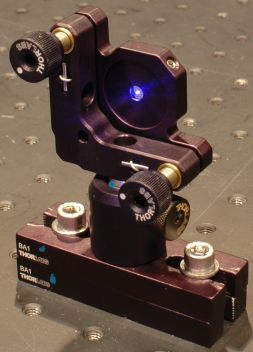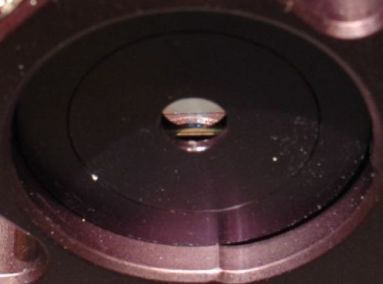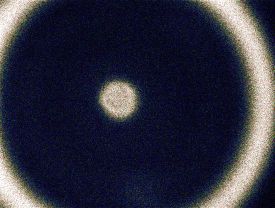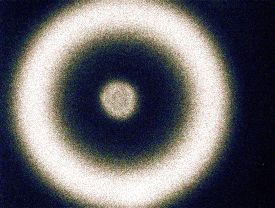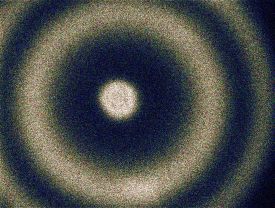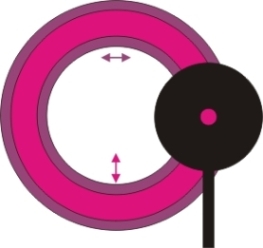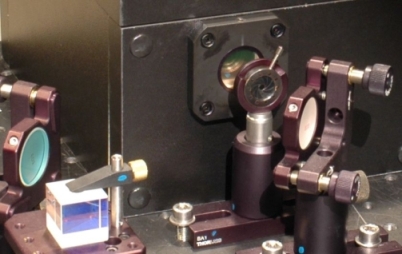Entanglement chapter B:
Generation of entangled photons
Entangled photons are generated with a combination of two nonlinear crystals [Kwi99]. First we explain how non entangled photons are generated in one crystal, than we combine two crystals to generate entangled photons.
Generation of photon pairs in one crystal
For all our experiments, we use a nonlinear crystal to generate photon pairs with horizontal polarization. The crystal is pumped by an vertical polarized 405nm laser (see chapters basics and coincidences). The down-converted photons are emitted on a cone around the pump beam (fig. 1). We have used a special camera *) to photograph this cone. The quantum state of the photon pair is described as
 .
.
The opening of the cone can be adjusted by tilting the PDC crystal as shown in video 1. For each of the 40 frames, the crystal has been tilted by 0.1°. The black-and-white intensity information has been electronically coded by colours (red and white are bright, blue is dim), i.e. the colours shown have nothing to do with the colour of the PDC light.
Figure 1: Geometry of PDC emission (left); photograph of PCD cone (right)
Video 1: PDC emission by tilting the crystal (Flash-Player 9 required) [Download]
Generation of entangled photons in a combination of two crystals
Entanglement of two photons is achieved in a composite crystal, which consists of two orthogonally oriented sections [Kwi99]. The pump laser polarization is then 45°. The vertically polarized component of the laser light generates PDC photon pairs in the first section, while the horizontal component generates PDC photon pairs in the second section (fig. 2; fig. 3). Under experimental conditions, it is very unlikely that two photon pairs are generated simultaneously within a coincidence interval. The opening of PDC cones can be adjusted separately for the first and the second section with two orthogonal rotation axes (fig. 4). As long as the two cones do not overlap, the origin of photons can be spatially distinguished. For overlapping cones, the origin of photons and hence the polarization state is not determined in principle: The photons are entangled. The entangled state is described by:
 .
.
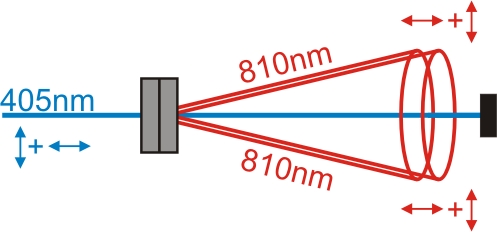
Figure 2: PDC crystal after Kwiat: Two otherwise identical crystals are combined with orthogonal orientation.
When the laser is polarised under 45°, both crystals emit pairs of PDC photons.
Figure 3: PCD device for entanglement (left) with two crystals (detail on the right).
Figure 4: PDC emission cone of the first section (left), the second section (center)
and both sections simultaneously (right).
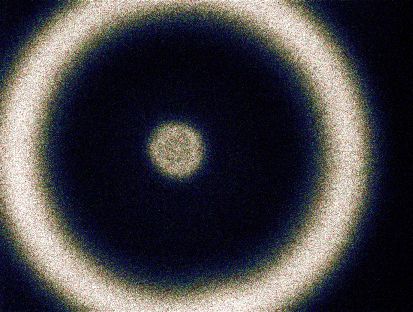
Figure 5: After proper rotation of the crystals, the PDC emission cones overlap.
Technical improvement of entanglement
The overlap of the PDC emission cones is not perfect. At the detectors the photons from the first crystal are emitted on a bigger ring, than photons form the second crystal. Some photon pairs are not entangled. This geometrical effect is reduced by narrowing down the viewing angle of the detector with an iris (fig. 6).
Figure 6: Small iris in front of detector for narrowing down the viewing angle
in order to improve degree of entanglement
*) The images of PDC cones have been photographed with an actively cooled infrared camera „Sensicam“ by PCO imaging. The camera was located without a lens a few centimetres behind the PDC crystal. The exposure time varied between 0.5s and 10s. We acknowledge the loan of a camera system by PCO - imaging.
To chapter C: Bell states [klick]
Back to overview [klick].
Author: P. Bronner, May 2008

![]() .
.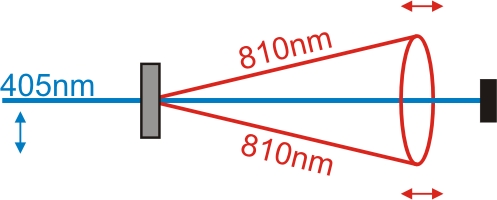
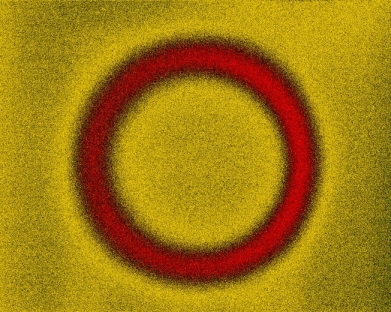
 .
.
